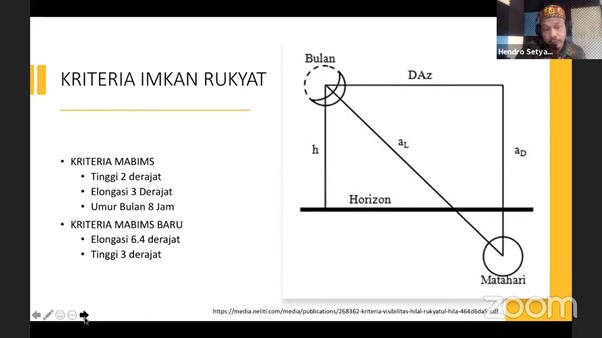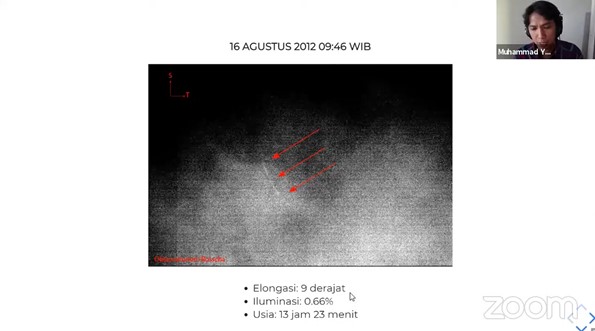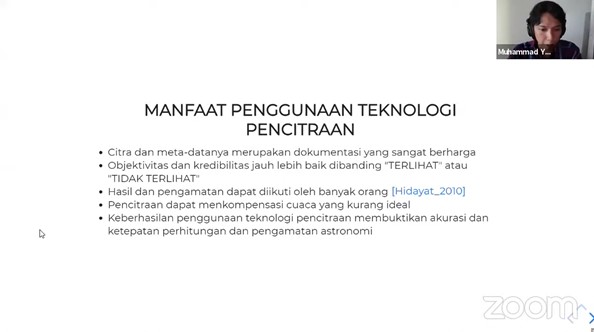Bosscha Observatory Virtual Gathering, Revealing Hilal and Its Observations
By Adi Permana
Editor Adi Permana

BANDUNG, itb.ac.id - The Bosscha Observatory held a Virtual Gathering as well as webinar with the theme of observing the new moon in a series towards Ramadan 1442 Hijri, Saturday (10/4/2021). The webinar was delivered by two experts in respective subjects, Hendro Setyanto, M.Sc. and Muhammad Yusuf, S.Si.
Hisab-Rukyat in the Determination of the Beginning of the Hijri Month
The first session of the webinar was delivered by Hendro Setyanto, M.Si. regarding the explanation of hisab-rukyat and how to determine the beginning of the Hijri month in Indonesia. He said that the calendar systems which are commonly used nowadays can be divided into 3 types, based on the orbits of celestial bodies used; lunar, solar, and solar-moon calendars.

"This presentation will be more focused on the Hijri calendar, which is based on the synodic cycle of the moon," he explained. He also added that the beginning of the month on the Hijri calendar is marked by the sight of the moon.
He explained that the rukyat hilal is an observation of the sighting of the moon's crescent (hilal) which is carried out on 29 Hijriah after sunset, as it was stated in the hadith, when the hilal is seen, it will determine the 1st of the new month. Otherwise, the next day will be determined as the 30th day of the month.
Hendro explained that there are certain criteria, which are called mabims criteria, to validate (imkan) the evidence of rukyat as a sign of the beginning of Ramadan. The new mabims criteria is including height (symbolized by the letter h in the picture) 3 degrees with elongation (symbolized by the letter aL in the picture) of 6.4 degrees. Furthermore, he explained that it is very likely that the rukyat testimony will be rejected, if the submitted evidence does not match the new mabims criteria.
"The important point that I’d like to convey is that Indonesia adheres to the Matlak Wilayatul Hukmi, which means that the evidence of rukyat in one location can be validated to be applied to the entire territory of Indonesia," he concluded.
The Development of Hilal Observation Method at Bosscha Observatory
The next presentation was opened by the explanation of hilal observation data from 8 to 10 years ago, which was delivered by Muhammad Yusuf, S.Si. In the observation of the hilal, the atmosphere that protects the Earth often reduces the contrast of the taken image of hilal. Therefore it is necessary to process the taken image by enhancing the sharpness and the contrast.
Yusuf also explained that the Earth’s protection atmosphere layers cause the blue color of the Earth's sky. Otherwise, the sky will be just black or dark, as it’s seen from Mercury. The Color of Earth’s sky is created due to white light from sunlight which interacts with air particles in the atmosphere, causing the white light to be scattered.

"The next obstacle is atmospheric refraction. Besides scattering the light, the atmosphere also bends the light that causes the actual positions of celestial bodies and the positions of visible celestial bodies to look different. "
Observation of the new moon has not been easy. Even though we have used telescopes and cameras, in extreme conditions, extra works are always required. Therefore, the moon observation will be conducted during the day. “The idea is tacking the movement of the moon during the day (when the moon becomes visible) until the dusk," he explained.

After the data is obtained, the image will be preceded by stacking the images into layers to overcome the noise from the dust that sticks to the observed camera, the process is including the obtaining the raw images, cleaning the images, stacking the images, and adjusting the contrast of the images.
As the close remark, Yusuf revealed the fact that each method (the reckoning and the rukyat) completes each other, there will be no reckoning without rukyat and also there will be no rukyat without reckoning.
Reporter: Athira Syifa P. S. (Postharvest Technology, 2019)
Translator: Naffisa Adyan (Oceanography, 2019)

.jpg)

.jpg)
.jpg)
.jpg)
